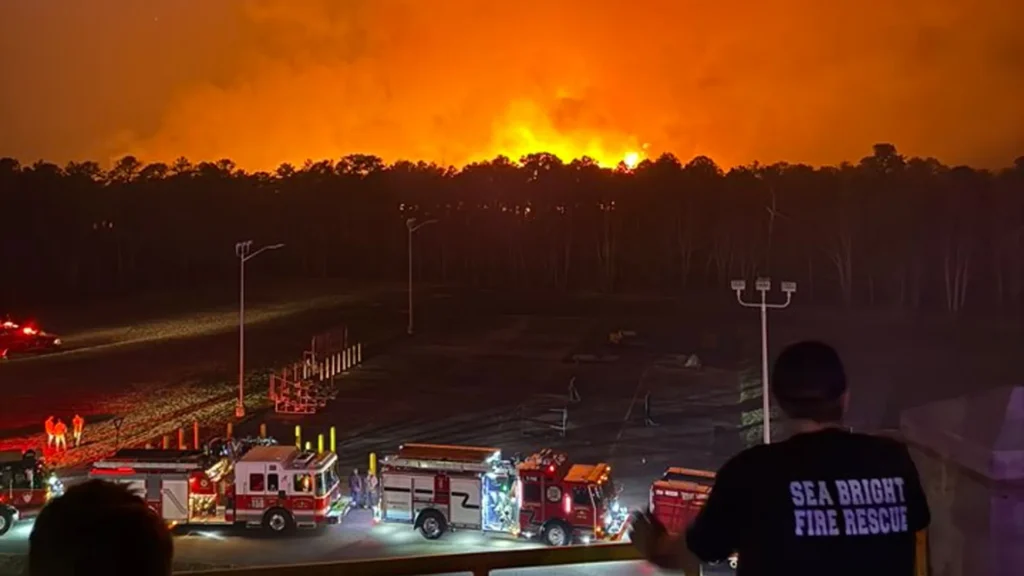Key Takeaways
- Jones Road Wildfire in New Jersey has ravaged more than 13 square miles of forest, forcing nearly 3,000 people to evacuate their homes for safety.
- The fire began in the Greenwood Forest Wildlife Management Area and rapidly expanded due to dry conditions and strong winds.
- Evacuation orders have been lifted, but residents are advised to remain cautious as firefighting efforts continue.
- Power outages affected around 25,000 customers as a safety measure during firefighting operations.
- The cause of the wildfire is under investigation, with no injuries reported thus far.
A Sudden Inferno: The Jones Road Wildfire’s Rapid Expansion
On Tuesday afternoon, flames erupted in the heart of the Greenwood Forest Wildlife Management Area in Ocean County, New Jersey. What started as a seemingly routine brush fire rapidly morphed into a monstrous blaze. Now known as the Jones Road Wildfire, the fire spread rapidly over night and eventually burned over 13 square miles of deep forest.
Thousands Evacuated Amid Growing Panic
As smoke billowed into the sky and embers carried on 25 mph gusts, emergency responders ordered evacuations across Ocean and Lacey Townships. In total, around 3,000 residents were forced to flee their homes, many with only minutes to gather belongings. Social media lit up with harrowing videos—orange skies, ash-covered roads, and neighbors helping neighbors.
A 7-mile stretch of the Garden State Parkway was temporarily shut down, paralyzing regional traffic and complicating emergency operations. Thankfully, as of early Wednesday, evacuation orders were lifted, and the highway reopened.
First Responders Battle Relentless Conditions
Over 100 firefighters from local departments and the New Jersey Forest Fire Service faced unpredictable winds and hazardous terrain. Aerial water drops, bulldozer lines, and backburning tactics were deployed in a coordinated effort to prevent further spread.
As of the latest update, the wildfire is only 10% contained. Officials remain cautiously optimistic but warn that shifting winds and dry vegetation still pose major threats.
Power Outage to Safeguard Crews
In a preemptive safety move, utility companies cut power to approximately 25,000 residents. Jersey Central Power & Light confirmed there’s currently no timeline for restoration. Utility workers are actively inspecting lines and equipment to assess fire-related damage before re-energizing the grid.
Nature’s Role: Drought, Wind, and the Pine Barrens
The Pine Barrens, known for its pitch pines and sandy soils, is a fire-prone ecosystem. Combined with ongoing drought, low humidity (20–40%), and gusty winds, conditions were ripe for ignition and rapid spread. Experts warn that climate change is likely intensifying these conditions, making large-scale wildfires more common in the region.
Local Response and Shelters Open

Emergency shelters were quickly established at area schools. Local police and fire departments, along with the Red Cross, coordinated efforts to assist displaced families. While the worst appears over for now, officials are urging residents to remain alert.
What Caused the Fire? The Investigation Begins
At this point, the exact cause remains unknown. Investigators are combing the burn zone for clues—looking into human activity, lightning strikes, or utility-related sparks. Officials stress that anyone with information should come forward.
Health Impacts: Smoke Drifts Beyond Jersey
Not only did the dense cloud of smoke suffocate the immediate vicinity, but it also spread. By Wednesday night, smoke from the fire was projected to reach as far as New York City and Long Island. Public health agencies advised vulnerable groups, like those with asthma or heart conditions, to limit outdoor exposure.
Conclusion
The Jones Road Wildfire in New Jersey is a wake-up call. It demonstrates how a spark may become an emergency when wind, drought, and thick vegetation come together in the right combination. While firefighting crews continue to monitor and battle the blaze, the event leaves a lasting reminder: proactive fire management and community preparedness are more critical than ever.


